Ilzam Nuzuli 1, S. Komariyah 2, Hr Cahyo Diartho 2
1Masters Program in Economics-Postgraduate Program
2Faculty of Economics and Business, University of Jember, Jember, Indonesia
Correspondence to: Hr Cahyo Diartho , Faculty of Economics and Business, University of Jember, Jember, Indonesia.
| Email: |  |
Copyright © 2020 The Author(s). Published by Scientific & Academic Publishing.
This work is licensed under the Creative Commons Attribution International License (CC BY).
http://creativecommons.org/licenses/by/4.0/

Abstract
Development progress in Banyuwangi Regency has an impact on changes in economic, social and environmental conditions. The purpose of this research: (1) Knowing the sustainability status of the Regional Spatial Plan in Banyuwangi Regency in terms of ecological, economic, social, legal and regulatory, institutional, infrastructure and technology dimensions (2) To formulate a sustainable Regional Spatial Planning policy in Banyuwangi Regency, to encourage the management of sustainable spatial management. This type of research uses a quantitative approach with quantitative descriptive methods. Data analysis method that used in this research is Multidimensional scaling analysis with Rapfish method. The results showed that the sustainability status of the Regional Spatial Plan in Banyuwangi Regency multidimensionally includes: the ecological, economic, social, legal and regulatory, institutional, infrastructure and technology dimensions have an influence on the sustainability of the Regional Spatial Plan in Banyuwangi Regency. The most influential dimension on the status of sustainability Regional Spatial Planning in Banyuwangi Regency is the economic dimension, compared with other dimensions (ecological, social, law and regulation, institutional infrastructure and technology).
Keywords:
Sustainability of Regional Spatial Planning, Rapfish Method
Cite this paper: Ilzam Nuzuli , S. Komariyah , Hr Cahyo Diartho , Regional Spatial Plan Analysis (RSP) in Banyuwangi Regency (Sustainability Development Perspective), American Journal of Economics, Vol. 10 No. 6, 2020, pp. 367-385. doi: 10.5923/j.economics.20201006.07.
1. Introduction
The growth paradigm is a development view that focuses on the economic sector. This paradigm has succeeded in increasing capital accumulation and per capita income of developing countries. However, the success of this paradigm has a negative impact, it is because the momentum of development is achieved by sacrificing the decline in the quality of ecological functions in the form of depletion of natural resources, social inequalities, and dependencies. This condition results in "sustainable development". The concept of sustainable development is the fulfillment of human needs to improve welfare through the use of resources without reducing the potential of future generations to utilize these resources (Grunkemeyer and Moss, 2012). Furthermore, it is a development with multidimensional insight in achieving a higher quality of life. Sustainable development includes three aspects, there are economic, social and environmental aspects. These three aspects cannot be separated from each other, because they cause a reciprocal relationship and influence each other (Kuhlmann, 2010).In addition, sustainable development has three main objectives: (1). Economically viable: dynamic economic development, (2). Socially-politically acceptable and culturally sensitive: development that is socially politically acceptable and sensitive to cultural aspects and (3). Environmental friendly: environment friendly. Sustainable development is also expected to reduce the impact of unstructured urban sprawl so that, cities become inefficient and ineffective in serving their lives (Kuhlmann, 2010).Relevance, to create a sustainable city requires five basic principles known as Panca E: Environment (Ecology), Economy (Employment), Eqiuty Engagement, and Energy. In addition, a sustainable city will definitely have a strong economy, a harmonious environment, a relatively equal level of social justice, high levels of community participation, and well-controlled energy conservation. (Budiharjo & Sutarjo (2005). Therefore, development in urban areas should be realized by applying the concept of environmentally friendly and sustainable development.The challenges of regional development planning in the perspective of sustainable development will not be separated from financial aspects. The challenge that must be faced is how to utilize spatial planning as a medium for regional development management. So the spatial plan is not only faced with the problem of how to implement it in the context of development, but also that the plan can be used as a tool that can estimate the amount of investment needed and how much revenue can be generated. (Cadman & Crowe, 2011).Various studies related to the interaction of space and environment, it has been identified that spatial planning plays an important role to overcome environmental problems that occur. Roggema (2009) explains that reduced vegetation in an area can cause an increase in temperature and increase the risk due to climate change. In a different opinion, Biesbroek et al. (2009) explained that mitigation and adaptation in anticipating climate change are closely related to the spatial dimension and need space for its implementation. This is also reinforced by the opinion of Fleischhauer (2008) which explains that spatial planning can play an important role in disaster mitigation through changes in urban structure and strengthening the resilience of an area or city. Referring to these conditions, spatial planning is demanded to not merely accommodate the spatial needs of a social and economic development. Spatial planning is required to begin to consider the impact of social and economic development in a region on the environment and even global. Spatial planning is demanded to be more environmentally friendly so that sustainable development can be realized.So what is key to the need for public policy is of course a concern for the good of the whole community in the long run. One approach to development that highlights the good for the community as a whole in the long run is found in the sustainable development approach. By using the perspective of sustainable development, planning is needed in order to realize the interests of the whole community through maintaining the natural environment (physical), economic and social life (Masik, 2005).Banyuwangi Regency have strategic geographical potential so that investors intensively invest in Banyuwangi Regency. Therefore, it is necessary to have a spatial planning and a strict development plan in order to encourage the improvement of the regional economy, of course also does not release attention to the carrying capacity of the environment and the use of space for the achievement of development oriented to the use of resources that are balanced, effective, efficient and sustainable. Integration of the plan between the Regional Spatial Planning as a tool in controlling development is very important and necessary for the realization of the functions and benefits of the optimal spatial area of Banyuwangi Regency.Rapid development progress in Banyuwangi Regency has an impact on changes in economic, social and environmental conditions. Acceleration of industrial or service growth and settlement result in reduced carrying capacity of the environment due to disposal of waste to the environmental media of water, soil and air. In addition, there is a change in the function of land that ignores the surrounding ecological function, it is feared that it will cause damage to forest and land ecosystems. Therefore, the importance of implementing Regional Spatial Planning (RSP) in regional development planning in Banyuwangi Regency so that the development process has a sustainability value. Relevance from background above, then this study aims to know the status of the sustainability of the Regional Spatial Plan (RSP) in Banyuwangi Regency in terms of ecological, economic, social, legal and regulatory, institutional, infrastructure and technology dimensions, and formulate a sustainable Regional Spatial Planning (RSP) policy in Banyuwangi Regency, so that it can encourage the management of sustainable spatial management.
2. Literature Review
2.1. Spatial Theory
Regional development requires two important instruments in implementing it, the first is the Development Plan and the second is Development Regulation. Without these two instruments development cannot proceed as it should. Development Plan is a city / region spatial plan which generally in all countries consists of 3 levels of plan namely; macro plan, meso plan, and micro plan. While the Development Regulation or also called the Zoning Regulation is a set of regulations that are used as a basis in preparing spatial plans starting from the highest level plan (macro plan) to the operational plan (micro plan) besides, it also functions as a tool control in the implementation of city development.To assist regional governments in managing their territories, a guideline as a technical reference is needed that can be further developed in accordance with the characteristics and requirements for pattern rules in spatial use that are increasingly urgent in line with the level of development of a city / region. Based on this, the local government needs to draw up rules for spatial use patterns or often referred to as Zoning Regulations. To maximize these activities, of course it is necessary to know the extent to which the rules of spatial use patterns can control any development or land use in the area concerned. Therefore, evaluation needs to be done by comparing land use with the applicable spatial plan so that it is known whether each land use in the area is in accordance with the established Spatial Plan.The term spatial planning is often mentioned on various occasions by various walks of life. This phenomenon is a sign that the beginning of a new era of understanding and recognition or legitimacy about the importance of spatial planning in the field of development. This is not apart from the Law No. 24 of 1992 concerning Spatial Planning as a legal basis. Rules can be interpreted as rules composition or how to arrange them. While space is a container or a place or can also be called the environment. In the opinion of Mabogunje in Adisasmita (2010) that space is divided into 3 types, namely:1. Absolute Space, is a container for the elements - elements in that space, such as; earth surface space which is a place to share continents, mountains, cities and so on2. Relative space, for example; If places A and B are close but there is no connecting road, while places A and C are far apart but there are roads and transportation equipment, then it is said that the AC distance becomes easier to reach and the space is relatively smaller.3. Space Relations, involving elements that have relations and interact with each other. Thus, development planning can be structured by space.Limitation and understanding according to Law No. 24 of 1992 concerning Spatial Planning, which is explained that Space is a container that covers land space, ocean space and air space as a single territory, where humans and other creatures carry out activities and maintain their survival. Spatial Planning is a structural manifestation and pattern of spatial use whether planned or not. Spatial planning is the process itself, spatial utilization and control of spatial use.Spatial planning is an important instrument for the government, the determination of the plan must get an agreement and the determination by the legislature as people's representatives and community support. Spatial planning legally has binding power to be obeyed by both the community and the government itself, so it is expected that the spatial use process can be carried out consistently. According to Law Number 26 of 2007 concerning Spatial Planning, the task of spatial planning actors, especially the state, is to organize spatial planning for the people's prosperity. In carrying out the tasks of the state, it provides the authority to organize spatial planning to the Central Government and Regional Government. The arrangement of spatial planning is carried out while respecting the rights of people in accordance with the provisions of the prevailing laws and regulations.Then the authority of the spatial planning actors in particular the Regency/City Government includes; (1) Arrangement, guidance, and supervision of the implementation of regency/city area spatial planning and strategic area; (2) Implementation of regency/city spatial planning; (3) Implementation of spatial planning in regency/city strategic areas; and (4) Cooperation in spatial planning between regencies/cities. Meanwhile, the authority of regency/city regional government in the implementation of regency/city spatial planning includings; (1) Regency/city spatial planning; (2) Utilization of regency/city area space; and (3) Control of spatial use of regency/city areas. When regional government cannot meet the minimum service standard in the area of spatial planning, the provincial local government can take steps to settle it in accordance with the provisions of the legislation.
2.1.1. Concept of Spatial Planning
The concept of spatial planning must be able to be an instrument that encourages and preserves the occurrence of various forms of balance in life in an area, whether the balance of the environment (ecosystem), social balance, or other equilibrium, and the last idea will inevitably become a condition for the existence of social participation in a series of arrangements space planning and in its application.Regional spatial planning has an important role in regional economic development. Regional planning must be integrated with national planning aimed at improving the welfare of the people in the region. The role of spatial planning is essentially intended to achieve optimal utilization of resources as much as possible to avoid conflicts over the use of resources, prevent environmental damage and increase harmony. Within the scope of spatial planning, land use and allocation are a part of it inseparable from the concept of space in development (Imran, 2013).The mindset of a spatial planning approach that sees society as a homogeneous object of regulation, needs to be changed by viewing society as a subject of regulation with a diversity of behavior. This new approach in the spatial planning concept requires the government to play a role in exploring and developing a shared vision between the Government and community groups in the area in formulating future spatial concepts, spatial quality standards, and activities desired or prohibited in a planned area (Haeruman, 2004). Following on the diagram of the classification scheme of spatial planning concepts: | Figure 1. Classification Scheme of Spatial Planning Concepts (Source: Law Number 26 of 2007 concerning Spatial Planning) |
2.2. Theory of Sustainable Development
The Limit to Growth model has received sharp criticism from economists because the economic fundamentals used are very weak. However, the book made people aware of the importance of sustainable development. Then, in 1987 the World Commission on Environmental and Development (WECD) or known as the Brundland Commission published a book called Our Common Future. In the context of sustainable development, it states that sustainable development is one that meets the needs of the present without comprimising the ability of the future generations to meet their own need (Fauzi, 2004). Furthermore,that the Brundtland report integrates two different approaches between radical approaches and reformist. The radical approach explicitly links environmental and development issues. While the reformist approach is to promote human development as a solution. Furthermore, sustainable development is defined as a condition in which human survival does not exceed the carrying capacity (carrying capacity) of ecosystem maintenance, to improve the quality of human life. In order to achieve living standards (standards of living) it is necessary to maintain a balance of carrying capacity and protection of biodiversity (IUCN, UNEP, & WWF, 1991).According to (IUCN, UNEP, & WWF, 1991), related sustainable development of the four components that need attention, there are, equity, participation, diversity, integration, and long-term perspective. The basic principles of sustainable development are described as follows:1. Development that Guarantees Equity and Social JusticeEven distribution of land and factors of production, equal distribution of roles and opportunities of women, even distribution of the economy achieved with a balanced distribution of welfare. But equity is not something that can be directly achieved. Equity is a relative concept and cannot be directly measured. The ethical dimension of sustainable development is comprehensive, the income gap between rich and poor countries is widening, even though equity in many countries has increased. Another ethical aspect that needs to be addressed by sustainable development is the prospect of future generations that cannot be compromised with the activities of present generation.2. Development that Affects DiversityThe preservation of biodiversity is a prerequisite for ensuring that natural resources are always available sustainably for the present and the future.3. Development Using an Integrative ApproachSustainable development prioritizes the relationship between humans and nature. Humans affect nature by using it or damaging it. This explains that there is a link between natural systems and social systems. By using this understanding, the implementation of a more integrative development is a development implementation concept that can be possibly done. This is a major challenge in the institution.4. Development That Requests a Long-Term PerspectiveThe impression of the meaning of sustainability is the challenge that underlies the evaluation of development activities. Long-term perception is a perspective of sustainable development. Until now the short-term framework has dominated the thinking of economists' decision-making, and therefore needs to be considered. | Figure 2. Concept of Sustainable Development |
Sustainability is not a simple concept but rather complex, because the understanding of sustainable development is important to be improved, especially for policy makers both macro and micro scale in order to achieve development goals. The concept of sustainable development considers the aspects of sustainability and formulates various strategies to be a reference in achieving development goals. The concept of Sustainable Development can be seen in the picture above.In the picture above explains the need The application of the Concepts, Principles and Goals of Sustainable Development in the broadest development that can be carried out by establishing the following rules (Djajadiningrat, 1992; Pearce and Warford, 1993):1. Equity and Justice Equity and Justice concerns the ethical dimension, where the gap between rich and poor countries or regions and the future of future generations cannot be compromised with the activities of present generation. Equality and Justice must be answered both for the present generation and for future generations. Therefore development strategies and planning must be based on premises such as; distribution of land tenure, distribution of factors of production, equal distribution of roles and opportunities for women, marginalized groups, and so on.2. Integrative Approach.Sustainable development prioritizes the relationship between humans and nature. Humans influence nature in beneficial or destructive ways. Sustainability of the future is only possible if the understanding of the complex interrelationships between natural and social systems can be understood and integrative ways applied in development planning and implementation.3. Long Term Perspective (Long Term Perspective).Sustainable development requires an assessment that is different from the normal assumptions in the procedure for applying discounting. The long-term perspective is the vision of sustainable development while the current short-term vision still dominates decision making.4. Ecological Sustainability.Ecological sustainability guarantees the sustainability of the earth's existence. To ensure the ecological sustainability of the integrity of the environmental order must be maintained through efforts to increase the carrying capacity, assimilation and sustainability of the use of renewable resources.5. Economic Sustainability.Ensure sustainable economic progress and encourage economic efficiency. The three main elements to achieve macroeconomic sustainability are economic efficiency, sustainable economic prosperity, and increasing prosperity and prosperity distribution.6. Social and Cultural Sustainability Overall social and cultural sustainability is expressed in social justice, human dignity, and improving the quality of life for all humans. Sustainability of the socio-cultural aspect has targets: population stability, meeting basic human needs, maintaining cultural diversity, and encouraging local community participation in decision making.7. Political Sustainability.Political sustainability is characterized by respect for human rights, democracy, and the certainty of food, water and settlement security.8. Defense and Security Sustainability.Sustainability of the ability to face and overcome challenges, threats, disturbances both from within and from outside which can directly and indirectly can harm the integrity, identity, sustainability of the state and nation.
3. Research Methods
Regional Spatial Planning Analysis of Sustainable Development in Banyuwangi Regency will be reviewed from 6 dimensions including: ecological, economic, social, legal and regulatory, institutional, infrastructure and technology dimensions using the Multidimensional scaling (MDS) approach which is the development of the Rapfish method. The Rapfish method was previously used to assess the sustainability of capture fisheries (Fauzi, 2002). The six dimensions are then processed with the Multidimensional scaling (MDS) technique. The stages of Multidimensional scaling (MDS) analysis are as follows (Nurmalina, 2008):Table 1. Sustainability Status Categories of Regional Spatial Planning in Banyuwangi Regency based on Index Value Results of Rap-Regional Spatial Planning Ordination Analysis with MDS techniques
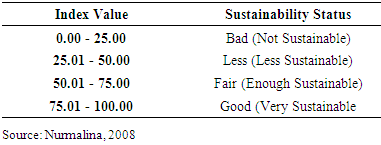 |
| |
|
1. determination of the attributes of the ecological, economic, social, legal and regulatory, institutional, infrastructure and technology dimensions as well as the attributes of each dimension are determined by the initial determination of the results of interviews and surveys;2. assessment of each attribute on an ordinal scale to determine sustainability in each dimension;3. index preparation and sustainability status at the location of the study area based on the scores that have been obtained. Sustainability level categories, namely: (a) not sustainable with a score of ≤ 25; (b) less sustainable with a score of 25-50; (c) quite sustainable with a score of 50-75; (d) sustainable with a score of 75-100;4. determination of the attributes of sensitive levers in each dimension, sensitive attributes are attributes that have a large and dominant role in determining the index value of the level of sustainability in each dimension.
4. Result and Discussion
1. Analysis of the Sustainability Status of Regional Spatial Planning in Bayuwangi Regency on Ecological Dimensiona. Rap-Regional Spatial Planning ordination analysis on the Ecological Dimension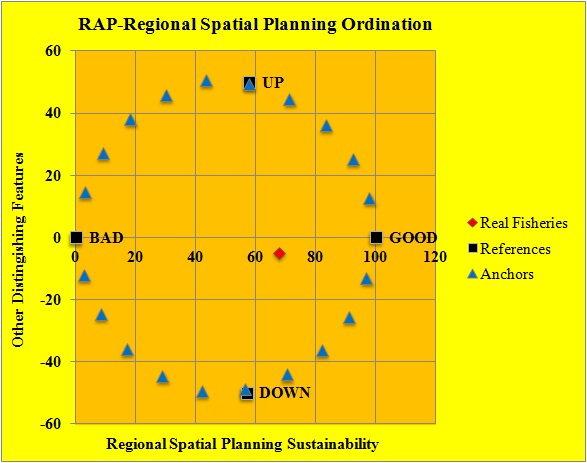 | Figure 3. Sustainability Index deep ecological dimension Regional Spatial Planning in Banyuwangi Regency (Source: data processed, 2019) |
Value of sustainability Regional Spatial Planning in Banyuwangi Regency in the ecological dimension that is equal to 68.07 and shows that the ecological dimension has a fairly sustainable status. Results Rap-Regional Spatial Planning ordination The ecological dimension has a pretty good analysis result because the stress value is 0.13 and the R2 value is 0.95, while the allowable stress value is not greater than 0.25 and the R2 value is not greater than 1.b. Leverage analysis attribute on the Ecological DimensionThe results of the analysis of leverage of attributes from the ecological dimension are seen in Figure 4: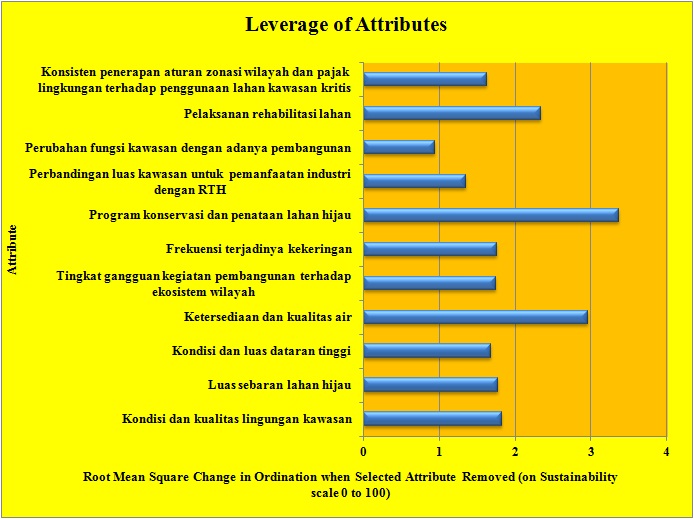 | Figure 4. Leverage analysisattributes dimension ecology in Regional Spatial Planning in Banyuwangi Regency (Source: data processed, 2019) |
Root Mean Square (RMS) values in the ecological dimensions can be seen in table 2:Table 2
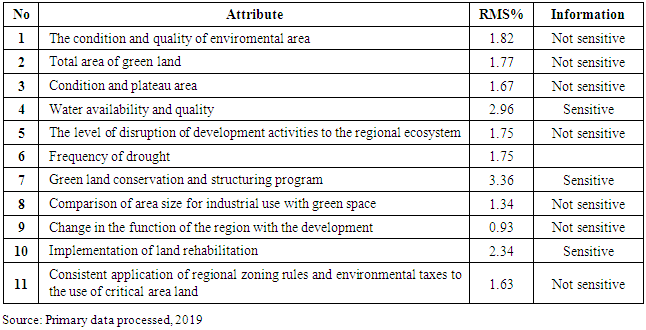 |
| |
|
The influence of attributes that are sensitive and have a greater influence on Regional Spatial Planning in Banyuwangi Regency are the availability and quality of water, Green land conservation and structuring program, implementation of land rehabilitation, where all three of these attributes have a very high RMS value compared to other attributes that will be very influential on Regional Spatial Planning in Banyuwangi Regency.c. Monte Carlo Analysis on the Ecological DimensionThe results of the Monte Carlo analysis on the ecological dimension on RPS in Banyuwangi Regency can be seen in figure 5: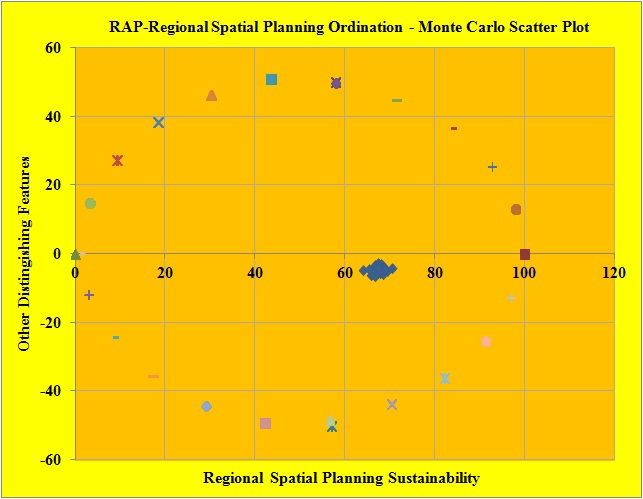 | Figure 5. Monte Carlo dimension analysis ecology in Regional Spatial Planning in Banyuwangi Regency (Source: data processed, 2019) |
Analysis of monte carlo's dimensions ecology shows good results (does not have a significant error range) is shown by the position of the ordination points that are close to each other shows that the results of repetition as many as 25 times are in the range of values 64.17 - 70.59.2. Analysis of the Sustainability Status of Regional Spatial Planning in Bayuwangi Regency on the Economic Dimensiona. Rap-Regional Spatial Planning ordination analysis on the Economic Dimension | Figure 6. Sustainability Index of the economic dimension in Regional Spatial Planning in Banyuwangi Regency (Source: data processed, 2019) |
Value of sustainability Regional Spatial Planning in Banyuwangi Regency on dimensions the economy which is 78.01 and shows that in the dimensions the economyhas a fairly sustainable status. Results in Rap-Regional Spatial Planning ordination dimension the economy has a pretty good analysis result because the stress value is 0.13 and the R2 value is 0.95, while the allowable stress value is not greater than 0.25 and the R2 value is not greater than 1.b. Leverage analysis attribute on the Economic DimensionThe results of the analysis of leverage of attributes from the economic dimension are seen in Figure 7. | Figure 7. Leverage analysis attributes dimension the economy in Regional Spatial Planning in Banyuwangi Regency (Source: data processed, 2019) |
Root Mean Square (RMS) values for each attribute in the economic dimension can be seen in table 3. Table 3
 |
| |
|
The influence of attributes that are sensitive and have a greater influence on Regional Spatial Planning in Banyuwangi Regency that is, Economic activities after the management of an industrial area, The economic value of the land that determines the area, The carrying capacity of the existence of supporting facilities for managing green areas where all three of these attributes have a very high RMS value compared to other attributes that will be very influential on Regional Spatial Planning in Banyuwangi Regency.c. Monte Carlo Analysis on the Economic DimensionThe results of the Monte Carlo analysis on the economic dimension on Regional Spatial Planning in Banyuwangi Regency can be seen in figure 8.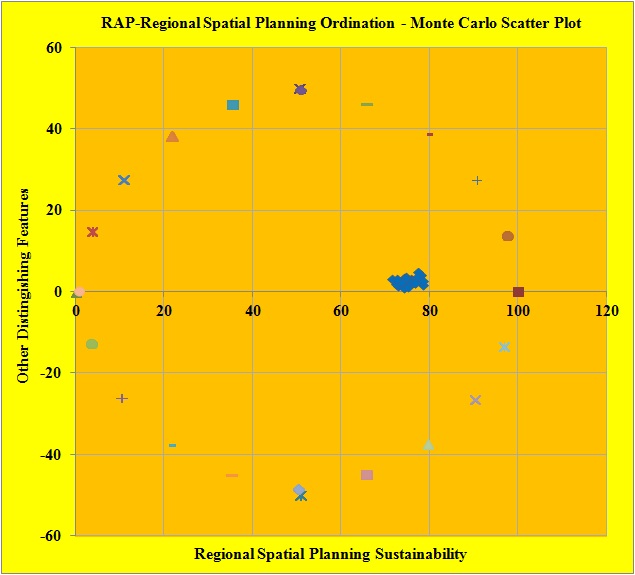 | Figure 8. Analysis of Monte Carlo dimensions the economy in Regional Spatial Planning in Banyuwangi Regency (Source: primary data processed, 2019) |
Analysis of monte carlo's dimensions the economy shows good results (does not have a significant error range) is shown by collecting the points (scatter plot) of the results of repetition Multidimensional scaling (MDS) or an ordination point whose positions are close together. The position of the ordination point close to each other shows that the results of 25 repetitions are in the range of values 71.51 - 78.45.3. Sustainability Status Analysis of Regional Spatial Planning in Banyuwangi Regency on the Social Dimensiona. Rap-Regional Spatial Planning ordination analysis on Social DimensionsThe results of the rapfish analysis were modified to be Rap-Regional Spatial Planning ordination, note the value of sustainability Regional Spatial Planning in Banyuwangi Regency on dimensions social which is 77.77 and shows that in the dimensions social has a fairly sustainable status.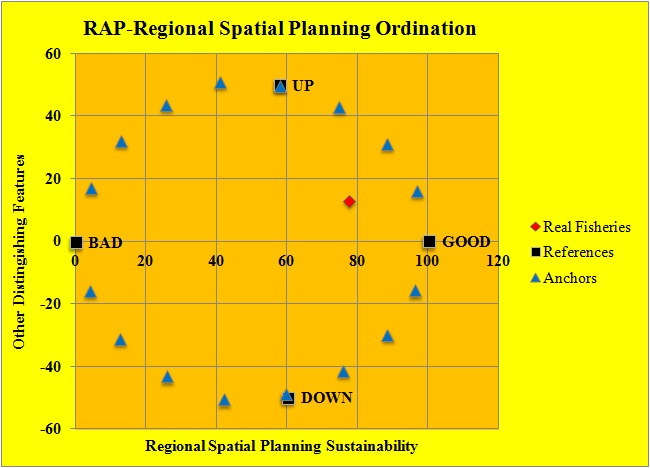 | Figure 9. Sustainability Index in the social dimension Regional Spatial Planning in Banyuwangi Regency (Source: primary data processed, 2019) |
b. Leverage analysis attribute on the Social DimensionThe results of the analysis of leverage of attributes from the social dimension can be seen in Figure 10.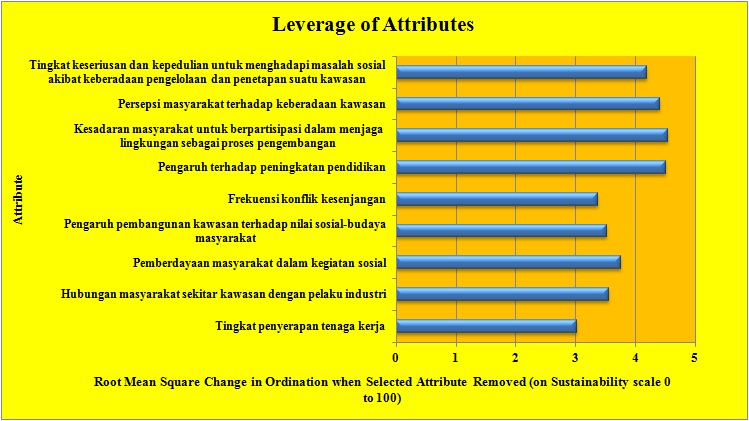 | Figure 10. Leverage Analysis attributes dimension social in Regional Spatial Planning in Banyuwangi Regency (Source: data processed, 2019) |
Root Mean Square (RMS) values for each attribute in the social dimension can be seen in table 4.Table 4
 |
| |
|
Based on Figure 10 and Table 4 can be seen the results of the analysis of leverage attributes or sensitive attributes on the social dimension. In this result, all the social dimension attributes have RMS value more than equal 2%. The influence of attributes that are sensitive and have a greater influence on Regional Spatial Planning in Banyuwangi Regency that is Public awareness to participate in protecting the environment as a development process, Influence on improving education, community perception of the existence of the region and the level of seriousness, where all three of these attributes have a very high RMS value compared to other attributes that will be very influential on Regional Spatial Planning in Banyuwangi Regency.c. Monte Carlo Analysis on Social DimensionsThe results of the Monte Carlo analysis on the social dimension on Regional Spatial Planning in Banyuwangi Regency can be seen in figure 11. | Figure 11. Monte Carlo dimension analysis social in Regional Spatial Planning in Banyuwangi Regency (Source: Primary data processed, 2019) |
Analysis of monte carlo's dimensions social shows good results (does not have a significant error range) indicated by the position of the ordination points that are close to each other shows that the results of 25 repetitions are in the range of values 71.45 - 78.24.4. Sustainability Status Analysis Spatial plans in Banyuwangi Regency in the Legal and Regulatory Dimensionsa. Rap-Regional Spatial Planning ordination analysis in the Legal and Regulatory Dimensions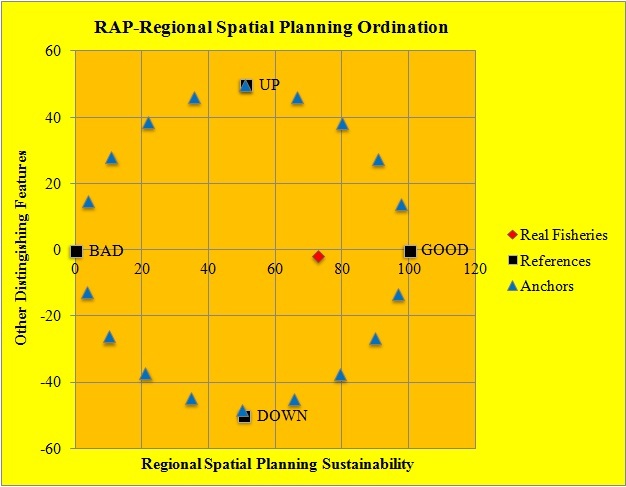 | Figure 12. Sustainability index of the legal and regulatory dimensions in Regional Spatial Planning in Banyuwangi Regency (Source: primary data processed, 2019) |
Rapfish analysis results on law and regulation dimensions which is 74.31 shows that in the social dimensions has a fairly sustainable status. Results Rap-Regional Spatial Planning ordination in law and regulation dimensions has a pretty good analysis result because the stress value is 0.13 and the R2 value is 0.95, while the allowable stress value is not greater than 0.25 and R2 value is not greater than 1.b. Leverage analysis attribute on the Legal and Regulatory DimensionsThe results of the analysis of leverage of attributes from the legal and regulatory dimensions can be seen in Figure 13.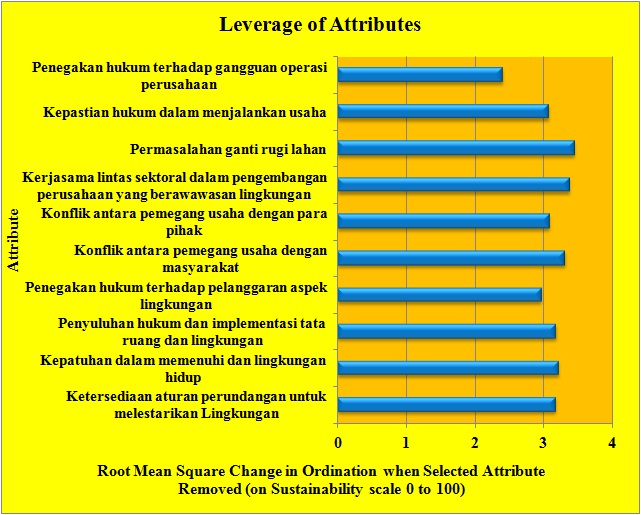 | Figure 13. Leverage Analysisattributes dimension law and regulation in Regional Spatial Planning in Banyuwangi Regency (Source: primary data processed, 2019) |
Root Mean Square (RMS) values for each attribute in the legal and regulatory dimensions can be seen in table 5.Table 5
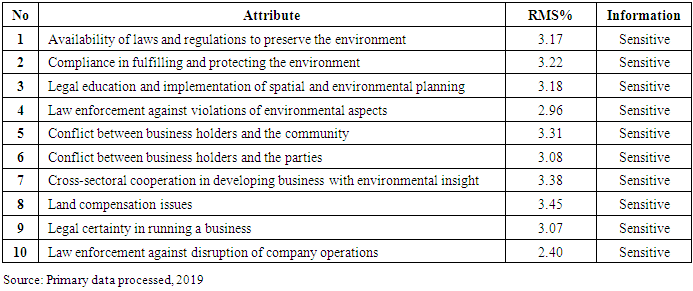 |
| |
|
The influence of attributes that are sensitive and have a greater influence on Regional Spatial Planning in Banyuwangi Regency that is Land compensation issues, Cross-sectoral cooperation in developing business with environmental insight, Compliance in fulfilling and protecting the environment, where all three of these attributes have a very high RMS value compared to other attributes that will be very influential on Regional Spatial Planning in Banyuwangi Regency.c. Monte Carlo Analysis on the Dimensions of Law and RegulationAnalysis of monte carlo's dimensions law and regulation shows good results (does not have a significant error range) indicated by the position of the ordination points that are close to each other shows that the results of 25 repetitions are in the range of values 69.15 - 74.94.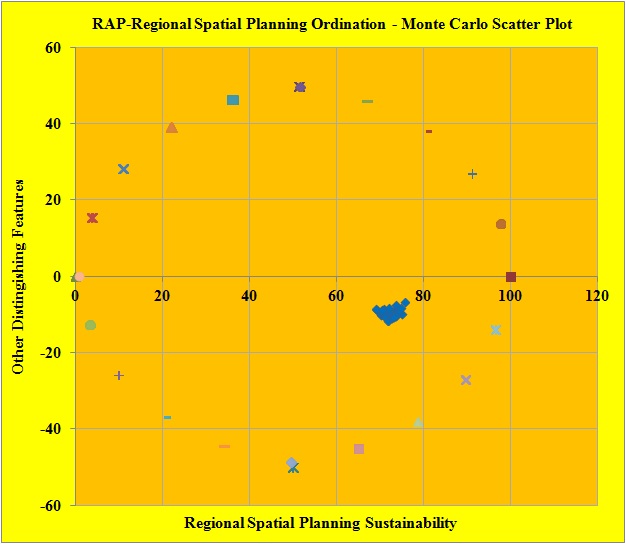 | Figure 14. Monte Carlo dimension analysislaw and regulation in RTRW in Banyuwangi Regency (Source: primary data processed, 2019) |
5. Sustainability Status Analysis Regional Spatial Planning in Banyuwangi Regency on the Institutional Dimensiona. Rap-Regional Spatial Planning ordination analysis on the Institutional DimensionRapfish analysis results in dimensions institutional which is 75.80 and shows that in the dimensions institutional has a fairly sustainable status. Results Rap-Regional Spatial Planning ordination dimension institutional has a pretty good analysis result because the stress value is 0.13 and the R2 value is 0.95, while the allowable stress value is not greater than 0.25 and the R2 value is not greater than 1.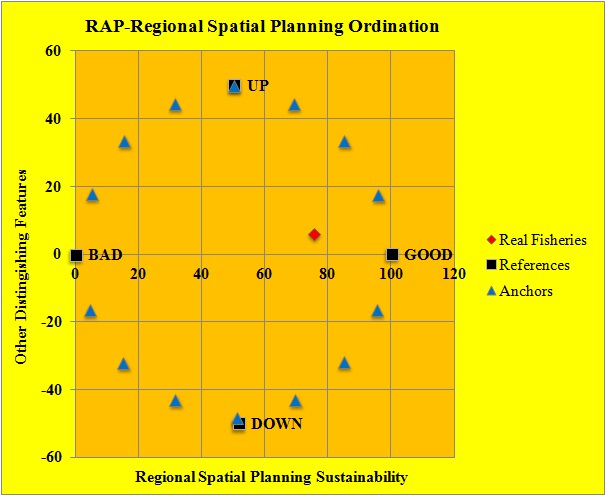 | Figure 15. Sustainability Index of institutional dimensions in the Regional Spatial Planning Banyuwangi Regency (Source: Primary data processed, 2019) |
b. Leverage analysis attribute on the Institutional DimensionThe results of the analysis of leverage of attributes from the institutional dimension can be seen in Figure 16.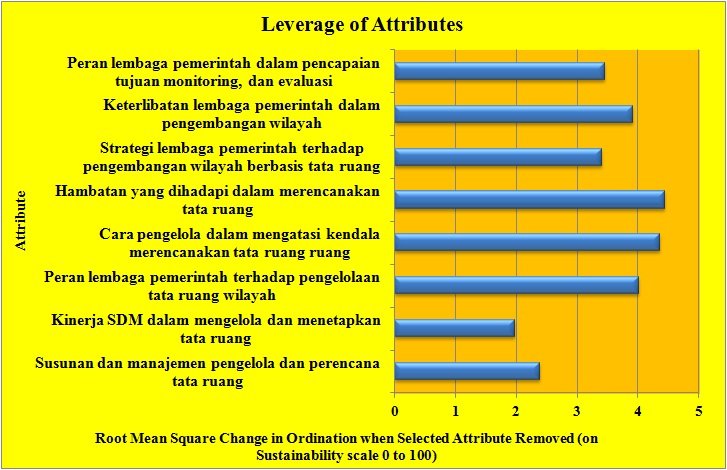 | Figure 16. Leverage Analysis attributes dimension institutional in Regional Spatial Planning in Banyuwangi Regency (Source: primary data processed, 2019) |
Root Mean Square (RMS) values for each attribute in the institutional dimension can be seen in table 6.Table 6
 |
| |
|
The influence of attributes that are sensitive and have a greater influence on Regional Spatial Planning in Banyuwangi Regency that is Obstacles encountered in spatial planning, The way managers in overcoming obstacles and obstacles encountered in spatial planning, The role of government institutions in the management of regional spatial planning, where these three attributes have a very high RMS value compared to other attributes that will greatly affect Regional Spatial Planning in Banyuwangi Regency.c. Monte Carlo Analysis on the Institutional DimensionThe results of the Monte Carlo analysis on the institutional dimension of the Regional Spatial Planning in Banyuwangi can be seen in Figure 17.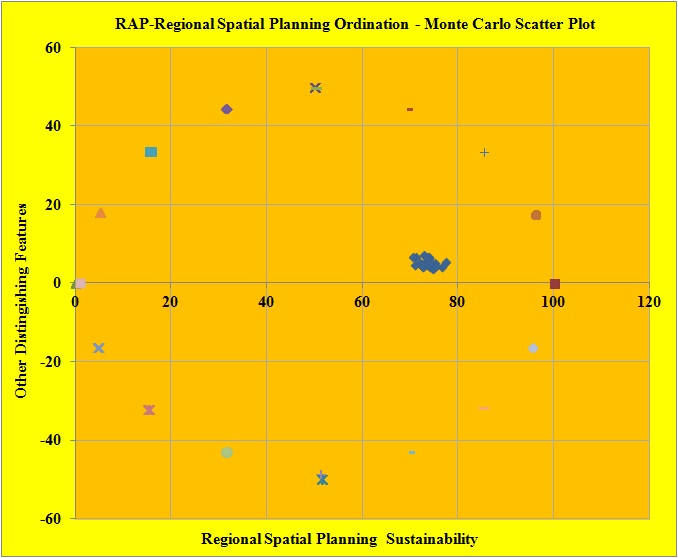 | Figure 17. Monte Carlo Dimension AnalysisInstitutional in Regional Spatial Planning in Banyuwangi Regency (Source: primary data processed, 2019) |
Analysis of monte carlo's dimensions institutional showed good results (did not have a significant error range) indicated the position of the ordination points that are close to each other showed that the results of 25 repetitions were in the range of values 70.54 - 77.27.6. Sustainability Status Analysis of Regional Spatial Planning in Banyuwangi in the Infrastructure and Technology Dimensionsa. Rap-Regional Spatial Planning ordination analysis on the Infrastructure and Technology Dimensions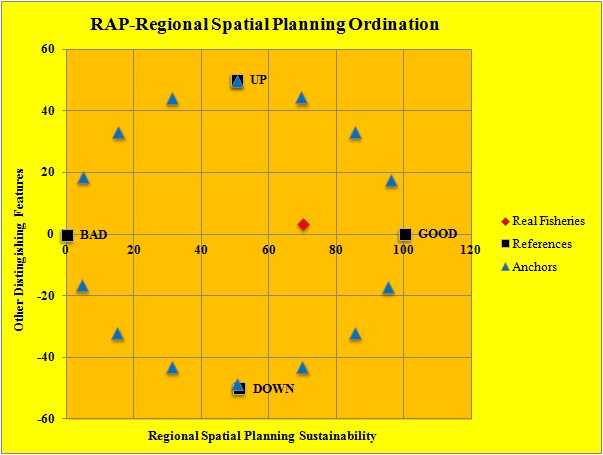 | Figure 18. Sustainability Index dimensions of infrastructure and technology in the Regional Spatial Planning in Banyuwangi Regency (Source: primary data processed, 2019) |
The results of the rapfish analysis were modified to be Rap-Regional Spatial Planning ordination, note the value of sustainability Regional Spatial Planning in Banyuwangi Regency on dimensions infrastructure and technology which is 70.24 and shows that in the dimensions infrastructure and technologyhas a fairly sustainable status. Results Rap-Regional Spatial Planning ordination dimension institutional has a pretty good analysis result because the stress value is 0.14 and R2 value is 0.94, while the allowable stress value is not greater than 0.25 and the R2 value is not greater than 1.b. Leverage analysis attribute on the Infrastructure and Technology DimensionsThe results of the analysis of leverage of attributes from the infrastructure and technology dimensions can be seen in Figure 19.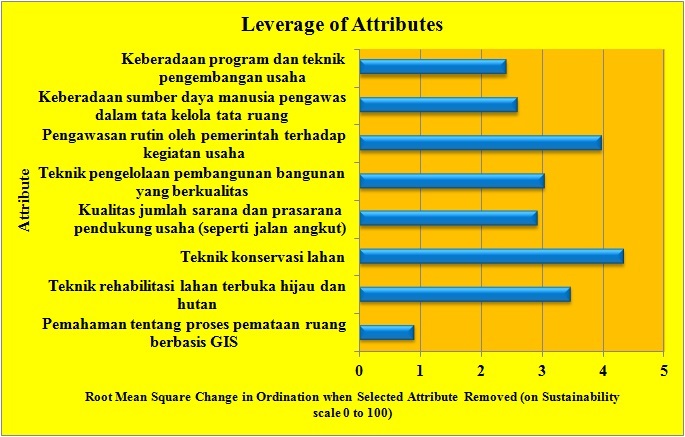 | Figure 19. Leverage Analysisattributes dimension infrastructure and technology in Regional Spatial Planning in Banyuwangi Regency (Source: primary data processed, 2019) |
The Root Mean Square (RMS) value for each attribute on the infrastructure and technology dimensions can be seen in table 7:Table 7
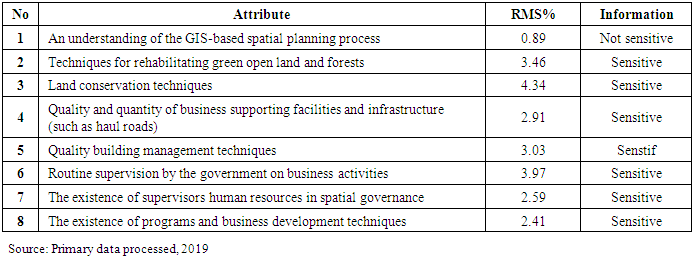 |
| |
|
The influence of attributes that are sensitive and have a greater influence on Regional Spatial Planning in Banyuwangi Regency that is Land conservation techniques, Routine supervision by the government of business activities, Green open land and forest rehabilitation techniques where all three of these attributes have a very high RMS value compared to other attributes that will be very influential on Regional Spatial Planning in Banyuwangi Regency.c. Monte Carlo Analysis on the Infrastructure and Technology DimensionsThe results of the Monte Carlo analysis on the dimensions of infrastructure and technology in the Regional Spatial Planning in Banyuwangi Regency can be seen in Figure 20.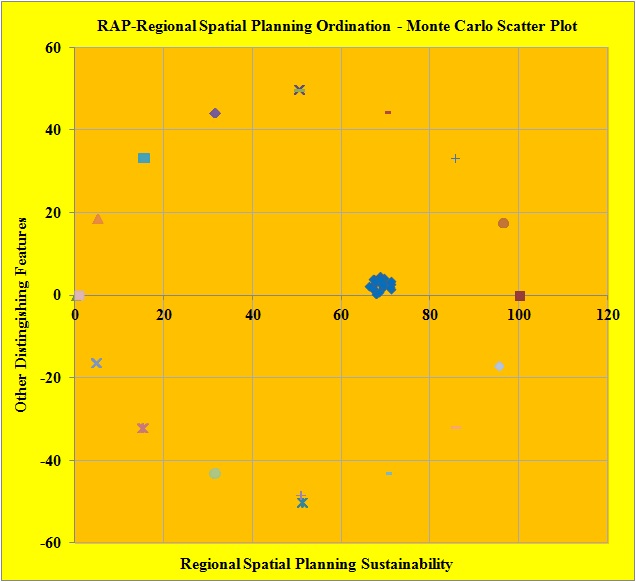 | Figure 20. Monte Carlo dimension analysisinfrastructure and technology in Regional Spatial Planning in Banyuwangi Regency (Source: primary data processed, 2019) |
Analysis of monte carlo's dimensions infrastructure and technology showed good results (did not have a significant error range) indicated the position of the ordination points close to each other showed that the results of 25 repetitions were in the range of values 66.08 - 71.30.7. Analysis of the sustainability status of the Regional Spatial Plan in Banyuwangi Regency MultidimensionallyThe sustainability status of the Regional Spatial Plan in Banyuwangi Regency on each dimension shows the following results:Table 8
 |
| |
|
The sustainability status in the ecological dimension is 68.07 which means that the dimension is still in the position of the ordination scale which is quite sustainable. The ecological dimension has 3 sensitive attributes by showing a pretty good result or not having a significant error range, this is indicated by the point of repetition of the Multidimensional scaling (MDS) analysis that collects between values 64.17 - 70.59 or the point of ordination that is still in a position that is close together. Status of sustainability in the economic dimension of 74.14 which means that the dimension is still in the position of the ordination scale which is quite sustainable. The economic dimension has 8 sensitive attributes by showing fairly good results or not having a significant error range, this is indicated by the point of repeating the results of Multidimensional scaling (MDS) analysis that collects between values 71.51– 78.45 or the point of ordination that is still in a position that is close together.Status of sustainability in the social dimension is 77.77 which means that the dimension is still in the position of the ordination scale which is quite sustainable. The social dimension has 9 sensitive attributes by showing fairly good results or not having a significant range of errors, this is indicated by the point of repeating the results of Multidimensional scaling (MDS) analysis that collects between values 71.45 - 78.24 or the point of ordination that is still in a position that is close together. The status of sustainability in the legal and regulatory dimensions is 74.31 which means that the dimension is still in the position of the ordination scale, quite sustainable. The legal and regulatory dimension has 7 sensitive attributes by showing fairly good results or not having a significant error range, this is indicated by the point of repeating the results of Multidimensional scaling (MDS) analysis that collects between values 69.15 - 74.94 or the point of ordination that is still in a position that is close together. Status of sustainability in the institutional dimension is 75.80 which means that the dimension is still in the position of the ordination scale which is quite sustainable. The institutional dimension has 10 sensitive attributes by showing good results or not having a significant range of errors, this is indicated by the point of repeating the results of Multidimensional scaling (MDS) analysis that collects between values 70.54 - 77.27 or the point of ordination that is still in a position that is close together. Status of sustainability in the infrastructure and technology dimensions of 70.24 which means that the dimension is still in the position of the ordination scale which is quite sustainable. The dimensions of infrastructure and technology have 7 sensitive attributes by showing good results or not having a significant error range, this is indicated by the point of repetition of Multidimensional scaling (MDS) analysis that collects between values66.08 - 71.30 or the point of ordination that is still in a position that is close together. After the sustainability status index values in each dimension, including ecological, economic, social, legal and regulatory, institutional, and infrastructure and technology dimensions are known, the sustainability status index values can be described in the elevated diagram as follows:Based on Figure 21 it can be seen that the results of multidimensional analysis show that the sustainability status of the Regional Spatial Planning in Banyuwangi is in a fairly sustainable status with a sustainability status index value of 74.03, the value is on the 60.01 - 75.00 ordination scale. To maintain and improve the status of sustainability in the future, it is necessary to intervene (repair) the attributes that affect the improvement of the sustainability status. In addition, it is necessary to prioritize the improvement of attributes on the dimensions of sustainability that have a lower sustainability index value, and the improvement of the attributes should not only be done on attributes that are sensitive to affect the improvement of sustainability status, but also insensitive attributes so that the status of sustainability can be improved close to the value of a 100 percent sustainability index. Of course, with consideration of financial ability, time, and energy.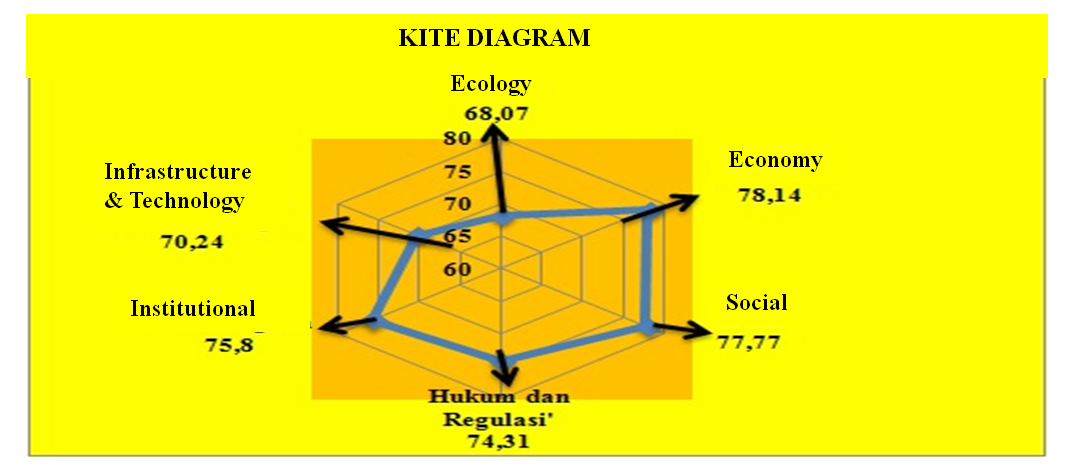 | Figure 21. RTRW sustainability status index value in Banyuwangi Regency with a Kite Chart |
5. Conclusions and Suggestion
The results of this study provide the conclusion that The sustainability status of the Regional Spatial Planning in Banyuwangi Regency is multidimensionally in a fairly sustainable status with a sustainability status index value of 74.03, the value is on an ordination scale of 60.01 - 75.00, meaning that the index value of all dimensions includes: ecological, economic dimensions, social, law and regulation, institutional, infrastructure and technology have an influence on the sustainability of the Regional Money Record Plan in Banyuwangi Regency. The most influential dimension on the status of sustainability Regional Spatial Planning in Banyuwangi Regency is the economic dimension, when compared with other dimensions (ecological, social, law and regulation, institutional infrastructure and technology). The economic dimension has the highest value of the sustainability index and has a great opportunity to improve the status of sustainability Regional Spatial Planning in Banyuwangi Regency.In addition, some recommendations are given as follows (1). To maintain the sustainability status in the future it is necessary to improve the sensitive attributes or those that affect the sustainability status of the Regional Spatial Plan in Banyuwangi Regency and the improvement of the insensitive attributes so that the sustainability status can be increased by sensitive attributes and (2). For the realization of a spatial management system in sustainable development, an active role among competent institutions in this field is needed. Monitoring and evaluation in every activity, applying the scale of strategic priority policies carefully can help accelerate the realization of sustainable development coupled with the management of a spatial management system. It is expected that with the control, monitoring and evaluation can synergize the roles and functions in each of the existing dimensions.
References
| [1] | Archibugi, F. (2008). Planning Theory From the Political Debate to the Methodological Reconstruction. London: Sage Publication. |
| [2] | Biesbroek, G., Swart, R., & Knaap, WV (2009). The mitigation adaptation dichotomy and the role of spatial planning. Habitat international, 33 (3), 230-237. |
| [3] | Conyers, D., & Hills, P. (1987). An Introduction to Development Planning in The Third World. Brisbane: John Willey & Sons. |
| [4] | Regions, BP (2015). Banyuwangi Economic Growth Banyuwangi Regency. Banyuwangi Regency: Regional Development Planning Agency of Banyuwangi Regency. |
| [5] | Darmawati, Saleh, C., & Hanafi, I. (2017). Implementation of Regional Spatial Planning (RTRW) Policy in the Perspective of Sustainable Development. JISIP: Journal of Social and Political Sciences, 4 (2). |
| [6] | Djajadiningrat, S. (1992). The Concept of Sustainable Development in Building Without Damaging the Environment. Jakarta: Office of the State Minister for the Environment. |
| [7] | Faludi, A. (2000). The performance of spatial planning. Planning practice and Research, 15 (4), 299 - 318. |
| [8] | Fauzi, A. (2004). Economics of Natural and Environmental Resources, Theory and Application. Jakarta: Gramedia Main Library. |
| [9] | Fleischhauer, M. (2008). The role of spatial planning in strengthening urban resilience In Resilience of Cities to Terrorists and other Threats. Springer Science, 10, 273 - 298. |
| [10] | Friedman, J. (1987). Planning in the Public Domain. Oxford: Princeton University Press. |
| [11] | Friedman, J. (2003). Why Do Planning Theory? Planning Theory, 2 (1), 7-10. |
| [12] | Grunkemeyer, W., & Moss, M. (2012). Key Concepts in Sustainable Development. West Virginia: West Virginia University Regional Research Institute. |
| [13] | IUCN, UNEP, & WWF. (1993). Earth, a Forum for Strategies Towards Sustainable Life. Jakarta: PT Gramedia Pustaka Utama. |
| [14] | Jeong, JS (2016). Spatial Planning and Sustainable Development Measuring Regional Geographical Characteristics towards Ecotourism in Spanish Rural Housings. Wseas Transactions on Environment and Development, 12, 290 -298. |
| [15] | Korosewa, A., & Konvitz, J. (2001). Towards a new role for spatial planning. Paris: OECD. |
| [16] | Kuhlman, T. (2010). What is Sustainability? sustainability journal, 2 (11), 3436 - 3448. |
| [17] | Newman, P., & Jennings, I. (2012). Cities as sustainable ecosystems: principles and practices. Washington DC: Island Press. |
| [18] | Nurmalina, R. (2008). Analysis of Index and Status of Sustainability of Rice Availability Systems in Several Areas of Indonesia. Agro Economic Journal, 26 (1), 47 -79. |
| [19] | Nurmandi, A. (1999). Urban Management Actors, Organizations and Management of Urban Areas in Indonesia. Yogyakarta: Circle of the Nation. |
| [20] | Pearce, D., & Wardford, J. (1993). World Without End, Economics, Development. Oxford University Press. |
| [21] | Puspita, IB (2017). Realizing Environmental Friendly Spatial Planning through Land Based Emission Analysis. Online Journal of the National Institute of Technology, 1 (3), 1 - 9. |
| [22] | Ramandey, L. (2017). Analysis of the Effect of Spatial Planning on Regional Development Performance in Waropen Regency, Papua Indonesia. Journal of Presepitation, 14 (1), 37 - 40. |
| [23] | Rozikin, M. (2012). Analysis of the Implementation of Sustainable Development in Batu City. Journal of Political Review, 2 (2), 219 - 243. |
| [24] | Saaty, TL (1993). Decision Making for Leaders, Analytic Hierarchy Process for Decision Making in Complex Situations. Jakarta: PT. Pustaka Binaman Pressindo. |
| [25] | Salim, E. (1990). The Concept of Sustainable Development. Jakarta. |
| [26] | Statistics, BP (2015). Banyuwangi Regency in Figures. Banyuwangi Regency: Central Statistics Agency of Banyuwangi Regency. |
| [27] | Tarigan, R. (2004). Regional Development Planning. Jakarta: PT Bumi Aksara. |
| [28] | Taylor, N. (2000). Urban Planning Theory Since 1945. London: Sage Publications. |
| [29] | Law No. 24 of 1992 concerning Spatial Planning. (t.y.). |
| [30] | Law Number 26 of 2007 concerning Spatial Planning. (t.y.). |
| [31] | Law Number 32 of 2004 concerning Regional Government. (t.y.). |
| [32] | Law Number 32 of 2009 concerning Environmental Protection and Management. (t.y.). |
























 Abstract
Abstract Reference
Reference Full-Text PDF
Full-Text PDF Full-text HTML
Full-text HTML






